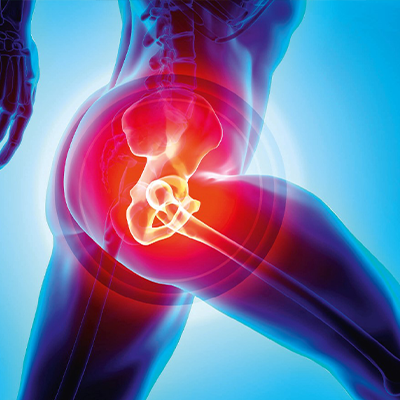The hip joints are important for mobility since they are essential for activities like running, bending, sitting, and jumping. Together with carrying a huge load, these joints work with some of the body’s biggest and strongest muscles. Hip joints can become damaged by disease, trauma, and wear and tear, which can cause discomfort and function loss. At NOVA Ortho & Spine our skilled orthopedic surgeons provides cutting-edge choices in hip orthopedic therapy.
The two ball and socket hip joints are formed by the pelvic bone and femurs and are joined by a number of ligaments and tendons. In addition, a complex arrangement of musculoskeletal tissues and bone connects the hip to the lower back and buttocks. Injuries to the hip and groin are frequent among active young people as well as the elderly due to acute injuries such as falls or car accidents.
Hip Disorders We Treat
Hip ailments and injuries range from deterioration of the bones and cartilage in the joints to damage to the muscles, tendons, and ligaments. Our orthopedic staff uses state-of-the-art medical technologies to accurately diagnose hip issues and choose the most appropriate course of therapy. Our orthopedic specialists look for the following hip conditions:
IMPINGEMENT OF FEMOROACETABULAR (FAI)
link- The femoral head (ball) and acetabulum (socket) are components of the ball and socket hip joint and are designed to fit together tightly for fluid motion. Femoroacetabular impingement, often known as hip impingement, is an unfortunate condition where the hip ball, socket, or both may be deformed due to heredity or other circumstances.
FAI occurs when irregular bone growth causes the bones in the hip socket to rub against one another. Bone spurs that create friction during movement and can harm cartilage can be found in the femoral head or acetabulum. There are several FAI presentations or types, such as:
- Excess bone on the acetabulum or hip socket known as a “pincher” that may affect the labrum or socket lining.
- The femoral head has ridges or spurs that generate friction because it is not exactly spherical.
- Combination – The pincher and cam may both be active simultaneously.
The signs of FAI
Not all FAI patients experience symptoms related to their bone problem. The likelihood that the bones will rub against one another and harm the cartilage or create pain increases with increased activity. Among the signs of FAI are some of the following:
- Hip rigidity
- Limping
- the outside of the hip or the groin
- Painful twisting, turning, or squatting may occur.
Treatment for femoroacetabular impingement depends on how severe the symptoms are. Physical therapy, NSAIDs for inflammation/pain, and steroid injections are examples of conservative treatments for mild to severe discomfort. FAI arthroscopy or surgery to remove bone growths may be suggested for more severe or persistent pain or functional problems that are not resolved by conservative therapy.
TEARING GLUTEUS MEDIUS
The gluteal muscles, which support hip and leg function, are the gluteus maximus, medius, and minimus. The gluteus medius plays a crucial role in abduction, rotation, and supporting the hip joint. The stability of the hip and the resulting reduced mobility can both be impacted by a torn gluteus medius.
Gluteus medius ruptures: Their causes and symptoms
The outside top of the femur bone and the outside side of the pelvis bone are where the gluteus medius is joined. This muscle permits the hip and leg to abduct, or swing outward, while stabilizing the hip’s outer side. The greater trochanter, or lower end of the muscle where it joins to the top of the femur, is where tears in the gluteus medius most frequently occur. High-impact sports injuries, repetitive motion, trauma, and degenerative illness are all potential causes of gluteus medius tears. The following are signs of a partial or whole gluteus medius rupture:
- the outer hip hurts
- ache in the outside hip during running or climbing stairs
- long-term walking or sitting-related pain
- Walking with a limp or dropping the unaffected hip
Surgery may be necessary to repair or reattach the gluteus medius and tendon in cases of significant injuries. For a quicker recovery, this procedure is frequently performed endoscopically through tiny incisions.
HIP IMPINGEMENT
Legs may move widely because to the hip joint’s ball and socket construction. However, it can affect how easily the joint can move if either the ball or the socket is somewhat misshaped. Hip impingement can happen when the labrum and cartilage are rubbed against anomalies in the pelvic bone socket or femoral head. Hip impingement is treated by our orthopedic doctors at NOVA Ortho & Spine at our medical facilities throughout Florida.
Impingement of the hip symptoms
FAI, or hip impingement, can occur in some people even when no symptoms are present. Even when there are no symptoms, the disease may be harming the labrum, which could eventually cause osteoarthritis and pain. Symptoms typically manifest as stiffness and soreness in the hip, groin, or front of the upper thigh for those who do experience them. While leaning forward at the hip or waist, such as when riding a bike or putting on shoes, the discomfort may get worse.
Treatment for hip impingement is based on how bad the symptoms are and how much the labrum has been harmed. Surgery can be performed to realign the bone and repair a broken labrum in more severe cases.
HIP INSTABILITY
Every day, the hip joints must support a tremendous amount of weight and strain. To maintain balance while walking, running, jumping, or even standing, the joint must be stable. Hip stability is a result of a variety of hip joint components, and issues with hip instability can arise when one of these components is injured. In order to alleviate hip instability and reduce pain, our surgeons at NOVA Ortho & Spine provides this service.
Hip Instability: Causes and Signs
The ball and socket of the hip joint are the apex of the femur and the acetabulum portion of the pelvic bone. These bones are supported by muscles and tendons and maintained in position by a number of ligaments. The labrum and cartilage in the joint seal and cushion the socket to provide smooth mobility. Hip instability may result from any injury or deformity to these parts. Stability may be lost as a result of injuries to ligaments, bone, tendons, muscles, or the labrum. Hip dysplasia, degenerative disease, and FAI are a few disorders and diseases that can also result in hip instability.
Hip instability can start slowly from a degenerative disease or other problems, or it can happen rapidly due to trauma such a gluteus medius rupture or joint fracture. Hip instability signs include:
- hip pain
- Hip joint clicking or popping feeling
- a slack or loose sensation
- Limping
While some hip instability problems can be managed conservatively with rest, ice, and anti-inflammatory drugs, others can call for professional medical attention. Hip instability increases the likelihood of osteoarthritis and other conditions while also endangering the joint. Depending on the etiology of hip instability, surgery, physical therapy, and injection therapy are all potential therapies.
Our orthopedic surgeons at NOVA Ortho & Spine can help you determine the best course of action to relieve your hip instability problems.
LABRAL REPAIR
The acetabulum (socket) and the head of the femur (ball) are joined to form the hip joint. The lining of the acetabulum needs cartilage to prevent the bones from rubbing against one another. The hip joint labrum is a ridge of cartilage on the rim of the acetabulum, and certain actions can cause hip labral tears. At our medical facilities in Florida, our orthopedic doctors at NOV Ortho & Spine provide cutting-edge hip labral tear treatment.
Around the rim of the acetabulum, the hip labrum—a combination of cartilage and connective tissue—runs. The labrum acts as a cushion between the hip joint’s ball and socket, which lessens friction while moving. The femur head remaining in its proper position aids in stabilizing the joint as well. Instability and inflammation of the hip joint may occur if the labrum is torn.
Hip labral tears: causes and symptoms
The labrum can be harmed by trauma, injuries, and general wear and tear. Hip labral tears can affect the hip joint’s functionality and cause a number of symptoms, such as:
- Sharp discomfort in the buttock, upper leg, or groin
- hip discomfort when extending the leg
- hip that clicks or catches when the leg is moved
- feeling of locking in the hip
Hip labral tear symptoms may appear suddenly as a result of an accident or injury, or they may appear gradually over time as a result of wear and strain. Once ruptured, the labrum typically does not heal by itself. Pain can be treated conservatively with rest, NSAIDs like ibuprofen, and physical therapy. Arthroscopy surgery to repair the tear may be used as a treatment for more serious hip labral tears.
LOOSE BODIES
The acetabulum of the pelvic bone, cartilage, and the head of the femur make up the big hip ball-and-socket joint. It is possible for fragments of bone and cartilage to separate from these parts, creating loose bodies inside the hip joint that may cause discomfort and functional problems.
Loose Bodies in Hip Joint: Causes and Signs
When you stand, walk, run, or even sit, the hip joint is always moving. The labrum and cartilage lining at the socket’s edge are being rubbed by the spinning femoral head inside the acetabulum. Small fragments of bone or cartilage may be released inside the joint as a result of injuries, trauma, degenerative conditions, or ordinary wear and tear. The following symptoms can be caused by this debris, which can also cause friction and interfere with joint movement:
- Hip stiffness and pain
- a feeling of locking or catching
- clicking or grinding
- limited rotational or motion range
Moving or migrating loose bodies in the hip joint is possible. If the debris shifts, you might feel discomfort and dysfunction before experiencing an abrupt relief. Depending on the quantity and location of the loose bodies, the symptoms may be ongoing or sporadic.
Anti-inflammatory drugs, rest, and cold packs are examples of conservative therapy that might temporarily relieve loose bodies in the hip joint. Treatment of loose bodies in the hip needs arthroscopic surgery to remove the bone and cartilage fragments from the joint if the symptoms are severe.
Your quality of life and performance may be impacted by hip pain and dysfunction. Contact our orthopedic experts at NOVA Ortho & Spine if you have a hip issue or injury.

